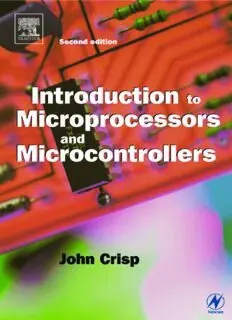
Introduction to Microprocessors and Microcontrollers PDF
Preview Introduction to Microprocessors and Microcontrollers
Introduction to Microprocessors and Microcontrollers This Page Intentionally Left Blank Introduction to Microprocessors and Microcontrollers Second edition John Crisp Newnes An imprint of Elsevier Linacre House, Jordan Hill, Oxford OX2 8DP 200 Wheeler Road, Burlington MA 01803 First published 1998 as Introduction to Microprocessors Reprinted 2000, 2001 Second Edition 2004 © 1998, 2004, John Crisp. All rights reserved The right of John Crisp to be identified as the author of this work has been asserted in accordance with the Copyright, Designs and Patents Act 1988 No part of this publication may be reproduced in any material form (including photocopying or storing in any medium by electronic means and whether or not transiently or incidentally to some other use of this publication) without the written permission of the copyright holder except in accordance with the provisions of the Copyright, Designs and Patents Act 1988 or under the terms of a licence issued by the Copyright Licensing Agency Ltd, 90 Tottenham Court Road, London, England W1T 4LP. Applications for the copyright holder’s written permission to reproduce any part of this publication should be addressed to the publisher. Permissions may be sought directly from Elsevier’s Science and Technology Rights Department in Oxford, UK: phone: (+44) (0) 1865 843830; fax: (+44) (0) 1865 853333; e-mail: [email protected]. You may also complete your request on-line via the Elsevier Science homepage (www.elsevier.com), by selecting ‘Customer Support’ and then ‘Obtaining Permissions’. British Library Cataloguing in Publication Data A catalogue record for this book is available from the British Library ISBN 0 7506 5989 0 For information on all Newnes publications visit our website at: www.newnespress.com Composition by Genesis Typesetting Limited, Rochester, Kent Printed and bound in Great Britain Contents Preface vii 1 Basic microprocessor systems 1 2 Binary – the way micros count 8 3 Hexadecimal – the way we communicate with micros 25 4 How micros calculate 38 5 An introduction to logic gates and their uses 49 6 Registers and memories 62 7 A microprocessor-based system 85 8 A typical 8-bit microprocessor 99 9 Programming – using machine code and assembly language 121 10 High-level languages 132 11 The development of microprocessors and microcontrollers 151 12 The Pentium family 173 13 The PowerPC 184 14 The Athlon XP 194 15 Microcontrollers and how to use them 199 16 Using a PIC microcontroller for a real project 219 17 Interfacing 234 18 Test equipment and fault-finding 255 Appendix A: Special function register file 267 Appendix B: PIC 16CXXX instruction set 268 Further reading 271 Quiz time answers 273 Index 275 This Page Intentionally Left Blank Preface The first edition of this book started with the words: ‘A modern society could no longer function without the microprocessor.’ This is certainly still true but it is even truer if we include the microcontroller. While the microprocessor is at the heart of our computers, with a great deal of publicity, the microcontroller is quietly running the rest of our world. They share our homes, our vehicles and our workplace, and sing to us from our greetings cards. They are our constant, unseen companions and billions are being installed every year with little or no publicity. The purpose of this book is to give a worry-free introduction to microprocessors and microcontrollers. It starts at the beginning and does not assume any previous knowledge of microprocessors or microcontrollers and, in gentle steps, introduces the knowledge necessary to take those vital first steps into the world of the micro. John Crisp This Page Intentionally Left Blank 1 Basic microprocessor systems The microprocessor was born In 1971 two companies, both in the USA, introduced the world to its future by producing microprocessors. They were a young company called Intel and their rival, Texas Instruments. The microprocessor and its offspring, the microcontroller, were destined to infiltrate every country, every means of production, and almost every home in the world. There is now hardly a person on the planet that does not own or know of something that is dependent on one of these devices. Yet curiously, so few people can give any sort of answer to the simple question ‘What is a microprocessor?’ This, and ‘How does it work?’ form two of the starting points for this book. Let’s start by looking at a system The word ‘system’ is used to describe any organization or device that includes three features. A system must have at least one input, one output and must do something, i.e. it must contain a process. Often there are many inputs and outputs. Some of the outputs are required and some are waste products. To a greater or lesser extent, all processes generate some waste heat. Figure 1.1 shows these requirements. 1
